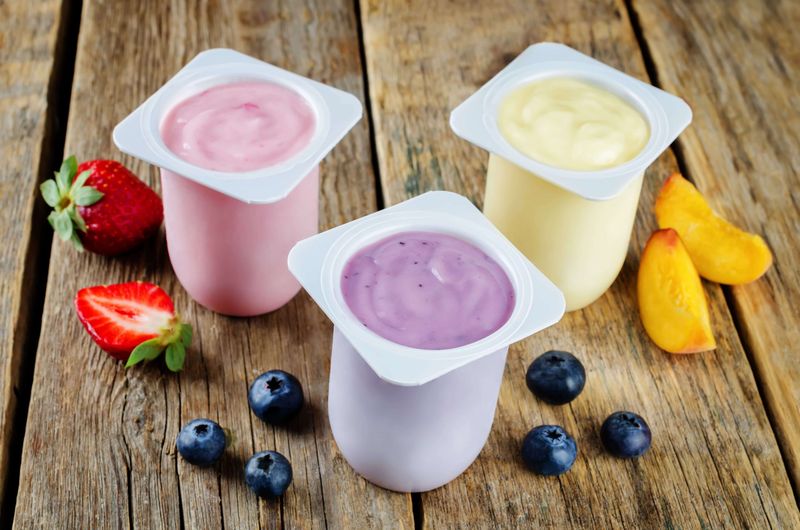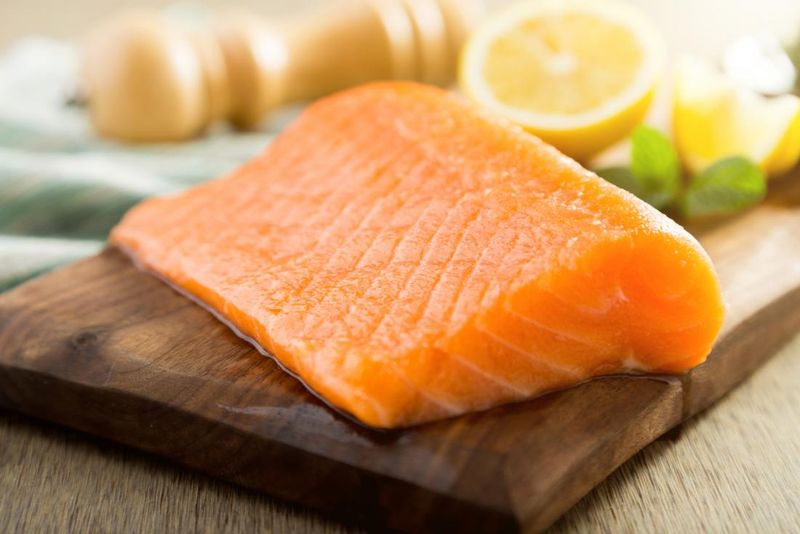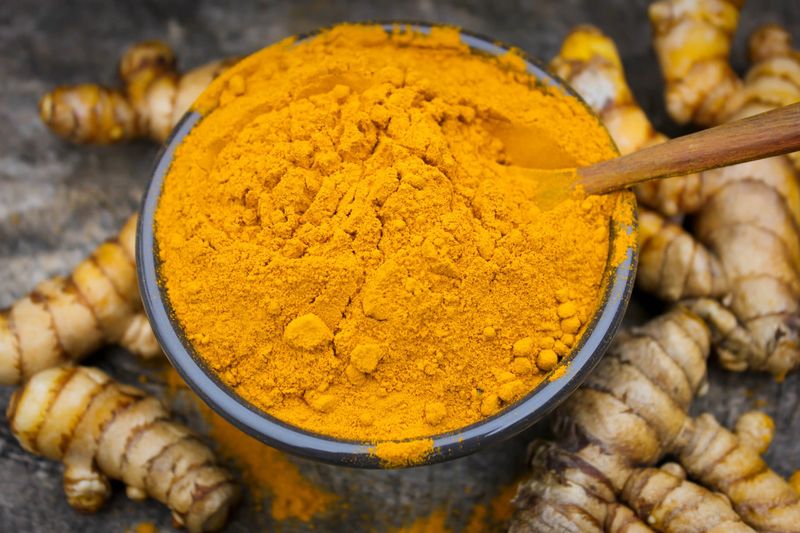Our food choices affect more than just our taste buds – they directly impact how our bodies feel each day. Inflammation is your body’s natural response to injury or infection, but when it becomes chronic, it can lead to serious health problems.
Some common foods in your kitchen might be silently causing harmful inflammation, while others have amazing powers to calm it down. Let’s explore what might be helping or hurting your body’s inflammatory response.
1. Sweet Sabotage: Fruit Yogurt’s Hidden Danger

That colorful fruit yogurt cup might seem like a healthy choice, but many contain as much sugar as a candy bar! The added sugars in commercial fruit yogurts trigger inflammation throughout your body.
When you eat these sweetened dairy products, your blood sugar spikes quickly. Your body responds by releasing inflammatory compounds that can make joints ache and worsen skin conditions like acne or eczema.
Instead, choose plain yogurt and add fresh fruit yourself. The natural probiotics in yogurt are actually anti-inflammatory, but they’re overshadowed when manufacturers add heaps of sugar, corn syrup, or artificial sweeteners.
2. Breakfast Betrayal: Processed Meats Inflame Your System

Bacon sizzling in the pan might smell heavenly, but processed meats like bacon, sausage, and deli slices contain compounds that trigger inflammation. These meats are preserved with nitrates and contain high levels of advanced glycation end products (AGEs).
Your body recognizes these compounds as threats, activating your immune system and causing inflammatory responses. Regular consumption has been linked to increased C-reactive protein levels – a key marker of inflammation in your bloodstream.
Limiting these breakfast staples to occasional treats rather than daily habits can significantly reduce your body’s inflammatory burden. Try replacing them with fresh, lean proteins like eggs or Greek yogurt.
3. White Bread Woes: How Refined Carbs Fan the Flames

That fluffy white bread might make a tasty sandwich, but refined carbohydrates like white bread, pastries, and crackers act like sugar in your body. They break down quickly, causing rapid blood sugar spikes that trigger inflammatory responses.
The refining process strips away fiber and nutrients, leaving behind food that offers little nutritional value while prompting your body to produce inflammatory compounds. Many people notice joint pain, brain fog, or skin problems worsen after eating these foods.
Switching to whole grain alternatives provides fiber that slows digestion and prevents those inflammation-triggering blood sugar spikes. Your body will thank you with more stable energy and less pain!
4. Crispy Culprits: Fried Foods Fuel Inflammation

French fries and doughnuts share a delicious crispy exterior that unfortunately comes with a heavy inflammatory price tag. The high-temperature cooking process creates compounds called advanced glycation end products (AGEs) that promote inflammation throughout your body.
The unhealthy oils used in frying become damaged when heated repeatedly, creating free radicals that cause oxidative stress in your cells. This triggers inflammatory responses linked to everything from acne flare-ups to increased arthritis pain.
Air-frying or baking offers similar crispy textures with significantly fewer inflammatory compounds. Many people report feeling less bloated and experiencing fewer digestive issues when they cut back on traditionally fried foods.
5. Liquid Trouble: Soda’s Inflammatory Impact

A single can of soda contains about 10 teaspoons of sugar – a massive inflammatory hit to your system! This sugar tsunami triggers immediate inflammatory responses throughout your body, from your brain to your joints.
The high-fructose corn syrup commonly used in sodas is particularly problematic, as it’s processed differently than other sugars. Studies show it increases inflammatory markers and may even alter gut bacteria in ways that promote chronic inflammation.
Swapping sugary drinks for water infused with fruit or herbs can dramatically reduce your inflammatory load. Many people report clearer thinking, better sleep, and decreased joint pain within days of cutting out soda.
6. Sneaky Spreads: Margarine’s Trans Fat Problem

That tub of margarine or vegetable shortening in your refrigerator might be a significant source of inflammation in your diet. Many contain artificial trans fats, created through a process called hydrogenation that makes liquid oils solid at room temperature.
Trans fats are particularly harmful because they trigger inflammatory responses while simultaneously lowering your good cholesterol (HDL) and raising bad cholesterol (LDL). Your body struggles to process these unnatural fats, leading to increased oxidative stress and inflammation.
Switching to olive oil, avocado oil, or even real butter in moderation provides healthier fats that don’t trigger the same inflammatory cascade. Your cell membranes, which are made of fats, will function better with natural options.
But not all foods are the enemy—some actually help calm the fire. Let’s look at a few inflammation-fighting powerhouses you’ll want to add to your plate.
1. Ocean’s Anti-Inflammatory Gift: Fatty Fish

Salmon, mackerel, and sardines contain powerful omega-3 fatty acids that actively fight inflammation in your body. Unlike the omega-6 fats found in processed foods that promote inflammation, these special fats help resolve it.
When you eat fatty fish, these beneficial oils get incorporated into your cell membranes and help produce compounds called resolvins and protectins. As their names suggest, these molecules help resolve inflammation and protect tissues from damage.
Eating fatty fish twice weekly provides enough omega-3s to notice differences in joint pain, skin clarity, and even mood. If you don’t enjoy fish, high-quality fish oil supplements can provide similar benefits, though whole food sources are always preferable.
2. Nature’s Colorful Medicine: Berries Fight Back

Blueberries, strawberries, and blackberries pack a powerful anti-inflammatory punch thanks to compounds called anthocyanins – the pigments that give them their vibrant colors. These plant compounds directly block inflammatory pathways in your body.
Research shows that eating berries regularly reduces levels of inflammatory markers in your bloodstream. Their antioxidant properties also protect your cells from damage that would otherwise trigger inflammatory responses.
Fresh or frozen, berries make a perfect snack or addition to breakfast. Their natural sweetness satisfies sugar cravings without causing the inflammatory response of refined sugar. Try adding a handful to your morning oatmeal or afternoon yogurt for a delicious inflammation-fighting boost.
3. Green Defenders: Leafy Greens Calm Inflammation

Spinach, kale, and other leafy greens contain an arsenal of anti-inflammatory compounds that help quiet your body’s inflammatory response. Their high vitamin K content regulates inflammatory processes, while their antioxidants neutralize free radicals that would otherwise cause inflammatory damage.
The fiber in leafy greens feeds beneficial gut bacteria that produce short-chain fatty acids with anti-inflammatory effects throughout your body. Many people with inflammatory conditions report significant improvement when they increase their greens intake.
Adding a handful to smoothies, eggs, soups, or stir-fries makes it easy to consume more without feeling like you’re eating salad all day. Even one cup daily can make a noticeable difference in how your body feels.
4. Golden Healer: Turmeric’s Powerful Protection

That bright yellow spice in your cabinet contains curcumin, one of nature’s most potent anti-inflammatory compounds. Turmeric has been used for thousands of years in traditional medicine to reduce pain and inflammation.
Modern research confirms what ancient healers knew – curcumin blocks inflammatory pathways at multiple points, essentially turning down your body’s inflammatory response. Adding black pepper dramatically increases absorption, as it contains piperine which enhances curcumin bioavailability by up to 2000%!
Try adding turmeric to scrambled eggs, smoothies, or rice dishes. For therapeutic effects, some people take supplements, but even culinary amounts can help reduce everyday inflammation when used regularly with a pinch of black pepper.
Leave a comment